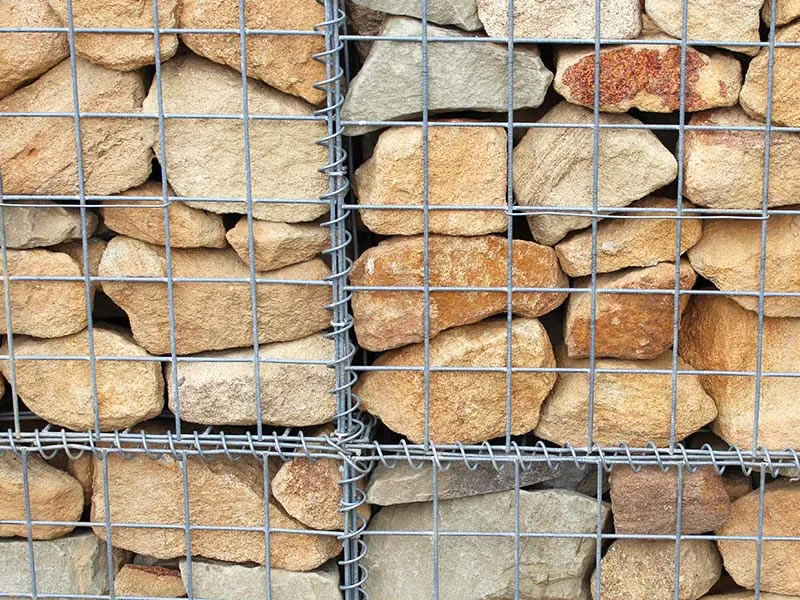These gabions are durable and suitable for various environmental conditions. Available in multiple wire diameters, dimensions, and unit sizes, they are tailored to meet specific project needs. Ideal for gravity retaining walls, architectural cladding, barriers, erosion control, landscaping, and infrastructure projects, Rentai's gabions provide both structural integrity and aesthetic value.

Welded mesh gabions are made from cold-drawn steel wire that is electrically welded together. The wire is available in stainless steel, hot-dip galvanized, or Alu-Zinc coated options to ensure durability. Additionally, the meshes can be polymer-coated to protect against corrosion and weathering effects, particularly in salty and highly polluted environments.
Welded mesh gabions are available in various sizes tailored for different uses, from structural projects to aesthetic applications.
1x1x1m Gabion: Ideal for general use in retaining walls and landscaping structures.
1.5×0.5×0.5m Gabion: Suitable for low retaining walls or garden borders, offering a longer and shallower design.
1.5x1x1m Gabion: Provides increased volume for larger soil retention or landscape features.
2x1x1m Gabion: Best for large-scale projects like extensive soil retention and sound barriers.
500x500x500mm Gabion (Israel): A smaller cube, perfect for detailed, compact projects.
Welded mesh gabions are available with a variety of coatings to enhance their durability and suit different environmental conditions.
Hot Dip Zinc Coated: This coating involves immersing the mesh in molten zinc, providing excellent corrosion resistance and is ideal for harsh environments.
Electro Galvanized: A thinner zinc coating applied electrochemically, suitable for indoor use or less corrosive environments.
Plastic/Polyester Coated: Available in green, black, and grey, this coating covers the galvanized wire with plastic or polyester to improve corrosion resistance and aesthetic appeal, making it suitable for landscapes and visible areas.
Galfan: A mixture of zinc and aluminum offers enhanced corrosion resistance compared to standard galvanization, particularly effective in coastal or polluted areas.
Gabions come with lacing wire for assembling adjacent units both horizontally and vertically. This lacing should be continuous along all joints, featuring alternating single and double loops spaced no more than 100mm apart for a tight joint. Each lacing sequence should start or end with three twists, with the free end tucked into the unit for added stability. For vertical joints, helical binders are available upon request, with the top and bottom turns rotated 90 degrees to prevent movement. Alternatively, CL50 ‘C’ rings can be used at every other mesh opening for final jointing to ensure adequate joint strength and maintain structural integrity.
Material Specifications
Fill welded mesh gabions with hard, durable materials such as rock, stone, or clean crushed concrete that are not susceptible to frost. The fill should be graded between 100mm to 150mm or 100mm to 200mm to ensure stability and proper drainage.
Filling Technique
Fill gabions in uniform layers no more than 300mm high to ensure even distribution and minimize voids. Stones should be densely packed, especially near the face, to enhance structural integrity and appearance. If large gaps are present, reposition the stones to fill these spaces effectively.
Use of Separation Panels
When using two types of fill materials, use pre-cut correx panels or geotextile to separate them if the secondary fill is finer than the primary. This helps maintain the structure of the gabion and prevents the materials from mixing.
Internal Bracing
Internal bracing is essential for the structural integrity of gabions, especially in exposed locations. It involves creating continuous windlass ties between the front and rear of the exposed cells. For 1-meter high gabions, two internal windlass bracings are required, positioned at one-third of the width and one-third height of the gabion to evenly distribute the load. Gabions at the ends of walls also need bracing in both directions to prevent deformation of the end faces.
Final Adjustments
Optionally, top off the gabion with a 20mm to 50mm layer of smaller aggregate to lock the larger stones in place and provide a neat finish. Ensure the gabion lid compresses the fill slightly to secure the materials and prevent settling.
Previous: Stainless Steel Wire Mesh, Welded
Copyright:@2020-2021
Comments Please sign in or sign up to post.
0
0 of 500 characters used